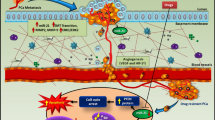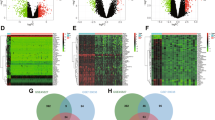Abstract
Background
It has been reported that enhancing the cellular levels of miR-193b as well as breast cancer-metastasis-suppressor-1 (BRMS1) protein is associated with diminished metastatic characteristics in breast cancer. In view of these facts, as a new therapeutic intervention, we employed a restoration-based strategy using both miR-193b-3p mimic and optimized BRMS1 in the context of a chimeric construct.
Methods
miR-193b-3p and BRMS1 genes were cloned and the resulting plasmids were transfected into the MDA-MB231, MCF-7 and MCF-10A cell lines. microRNA expression levels were assessed by rea time PCR using LNA-primer and protein expression was confirmed by western blot method. Then, apoptosis, MTT, colony formation and invasion assays were carried out.
Results
The expression levels of miR-146a, miR-146b and miR-373 were up-regulated, while the miR-520c, miR-335 and miR-10b were down-regulated following the exogenous BRMS1 expression. The exogenous over-expression of BRMS1 was associated with higher amounts of endogenous miR-193b-3p expression and enabled more efficient targeting of the 3′UTR of uPA. Although, miR-193b-3p and BRMS1 are individually capable of suppressing breast cancer cell growth, migration and invasion abilities, their cistronic expression was capable of enhancing the ability to repress the breast cancer cells invasion.
Conclusions
Our results collectively indicated the existence of an additive anti-metastatic effect between miR-193b-3p and BRMS1. Moreover, it has been hypothesized that the exogenous expression of a protein can effect endogenous expression of non-relevant microRNA. Our findings provide new grounds for miR-restoration therapy applications as an amenable anti-metastatic strategy.







Similar content being viewed by others
References
Garofalo M, Croce CM. microRNAs. Master regulators as potential therapeutics in cancer. Ann Rev Pharmacol Toxicol. 2011;51:25–43.
Jiang L, Sun D, Hou J, Ji Z. CircRNA: a novel type of biomarker for cancer. Breast Cancer. 2017;18:1–7.
Hashemi ZS, Forouzandeh Moghadam M, Soleimani M. Comparison of TGFbR2 down-regulation in expanded HSCs on MBA/DBM scaffolds coated by UCB stromal cells. In Vitro Cell Dev Biol Anim. 2015;51:495–506.
Choghaei E, Khamisipour G, Falahati M, Naeimi B, Mossahebi-Mohammadi M, Tahmasebi R, et al. Knockdown of microRNA-29a changes the expression of heat shock proteins in breast carcinoma MCF-7 cells. Oncol Res Featur Preclin Clin Cancer Ther. 2016;23:69–78.
Hashemi ZS, Khalili S, Forouzandeh Moghadam M, Sadroddiny E. Lung cancer and miRNAs: a possible remedy for anti-metastatic, therapeutic and diagnostic applications. Expert Rev Respir Med. 2017;11:147–57.
Bohl CR, Harihar S, Denning WL, Sharma R, Welch DR. Metastasis suppressors in breast cancers: mechanistic insights and clinical potential. J Mol Med. 2014;92:13–30.
Jafri MA, Al-Qahtani MH, Shay JW. Role of miRNAs in human cancer metastasis: implications for therapeutic intervention. Semin Cancer Biol. 2017;44:117–131
Hurst DR, Edmonds MD, Welch DR. Metastamir: the field of metastasis-regulatory microRNA is spreading. Cancer Res. 2009;69:7495–8.
Hu H, Li S, Liu J, Ni B. MicroRNA-193b modulates proliferation, migration, and invasion of non-small cell lung cancer cells. Acta biochimica et biophysica Sinica. 2012;44:424–30.
Long J, Ji Z, Jiang K, Wang Z, Meng G. miR-193b modulates resistance to doxorubicin in human breast cancer cells by downregulating MCL-1. Biomed Res Int. 2015;2015:1–9.
Hashemi ZS, Forouzandeh Moghadam M, Farokhimanesh S, Rajabibazl M, Sadroddiny E. Inhibition of breast cancer metastasis by co-transfection of miR-31/193b-mimics. Iran J Basic Med Sci. 2018;21:427–33.
Hashemi ZS, Moghadam MF, Sadroddiny E. Varying miR-193b-3p expression patterns in breast cancer cell lines indicates its potential for cancer management strategies. Int J Cancer Manag. 2018;11:1–9.
Leivonen S, Mäkelä R, Östling P, Kohonen P, Haapa-Paananen S, Kleivi K, et al. Protein lysate microarray analysis to identify microRNAs regulating estrogen receptor signaling in breast cancer cell lines. Oncogene. 2009;28:3926–36.
Li X, Yan P, Shao Z. Downregulation of miR-193b contributes to enhance urokinase-type plasminogen activator (uPA) expression and tumor progression and invasion in human breast cancer. Oncogene. 2009;28:3937.
Nanbu R, Menoud P-A, Nagamine Y. Multiple instability-regulating sites in the 3′untranslated region of the urokinase-type plasminogen activator mRNA. Mol Cell Biol. 1994;14:4920–8.
Seraj MJ, Samant RS, Verderame MF, Welch DR. Functional evidence for a novel human breast carcinoma metastasis suppressor, BRMS1, encoded at chromosome 11q13. Cancer Res. 2000;60:2764–9.
Nikolaev AY, Papanikolaou NA, Li M, Qin J, Gu W. Identification of a novel BRMS1-homologue protein p40 as a component of the mSin3A/p33 ING1b/HDAC1 deacetylase complex. Biochem Biophys Res Commun. 2004;323:1216–22.
Hurst DR, Mehta A, Moore BP, Phadke PA, Meehan WJ, Accavitti MA, et al. Breast cancer metastasis suppressor 1 (BRMS1) is stabilized by the Hsp90 chaperone. Biochem Biophys Res Commun. 2006;348:1429–35.
Perrella G, Lopez-Vernaza MA, Carr C, Sani E, Gosselé V, Verduyn C, et al. Histone deacetylase complex1 expression level titrates plant growth and abscisic acid sensitivity in Arabidopsis. Plant Cell. 2013;25:3491–505.
Kodura MA, Souchelnytskyi S. Breast carcinoma metastasis suppressor gene 1 (BRMS1): update on its role as the suppressor of cancer metastases. Cancer Metastasis Rev. 2015;34:611–8.
Welch D, Manton C, Hurst D. Chapter four-breast cancer metastasis suppressor 1 (BRMS1): robust biological and pathological data, but still enigmatic mechanism of action. Adv Cancer Res. 2016;132:111–37.
Edmonds MD, Hurst DR, Welch DR. Linking metastasis suppression with metastamiR regulation. Cell Cycle. 2009;17:2673–5.
Henry JC, Azevedo-Pouly ACP, Schmittgen TD. MicroRNA replacement therapy for cancer. Pharm Res. 2011;28:3030–42.
Meehan WJ, Welch DR. Breast cancer metastasis suppressor 1: update. Clin Exp Metastasis. 2003;20:45–50.
Zhang Y, Ye L, Tan Y, Sun P, Ji K, Jiang WG. Expression of breast cancer metastasis suppressor-1, BRMS-1, in human breast cancer and the biological impact of BRMS-1 on the migration of breast cancer cells. Anticancer Res. 2014;34:1417–26.
Shevde LA, Samant RS, Goldberg SF, Sikaneta T, Alessandrini A, Donahue HJ, et al. Suppression of human melanoma metastasis by the metastasis suppressor gene, BRMS1. Exp Cell Res. 2002;273:229–39.
Seraj MJ, Harding MA, Gildea JJ, Welch DR, Theodorescu D. The relationship of BRMS1 and RhoGDI2 gene expression to metastatic potential in lineage related human bladder cancer cell lines. Clin Exp Metastasis. 2000;18:519–25.
Lombardi G, Di Cristofano C, Capodanno A, Iorio MC, Aretini P, Isola P, et al. High level of messenger RNA for BRMS1 in primary breast carcinomas is associated with poor prognosis. Int J Cancer. 2007;120:1169–78.
Liu Y, Smith PW, Jones DR. Breast cancer metastasis suppressor 1 functions as a corepressor by enhancing histone deacetylase 1-mediated deacetylation of RelA/p65 and promoting apoptosis. Mol Cell Biol. 2006;26:8683–96.
Edmonds MD, Hurst DR, Vaidya KS, Stafford LJ, Chen D, Welch DR. Breast cancer metastasis suppressor 1 coordinately regulates metastasis-associated microRNA expression. Int J Cancer. 2009;125:1778–85.
Bhaumik D, Scott G, Schokrpur S, Patil C, Campisi J, Benz C. Expression of microRNA-146 suppresses NF-κB activity with reduction of metastatic potential in breast cancer cells. Oncogene. 2008;27:5643.
Tavazoie SF, Alarcón C, Oskarsson T, Padua D, Wang Q, Bos PD, et al. Endogenous human microRNAs that suppress breast cancer metastasis. Nature. 2008;451:147.
Ma L, Teruya-Feldstein J, Weinberg RA. Tumour invasion and metastasis initiated by microRNA-10b in breast cancer. Nature. 2007;449:682.
Huang Q, Gumireddy K, Schrier M, Le Sage C, Nagel R, Nair S, et al. The microRNAs miR-373 and miR-520c promote tumour invasion and metastasis. Nat Cell Biol. 2008;10:202.
Dittmer J. Mechanisms governing metastatic dormancy in breast cancer. Semin Cancer Biol. 2017.
Cicek M, Fukuyama R, Welch DR, Sizemore N, Casey G. Breast cancer metastasis suppressor 1 inhibits gene expression by targeting nuclear factor-κB activity. Cancer Res. 2005;65:3586–95.
Sliva D, Rizzo MT, English D. Phosphatidylinositol 3-kinase and NF-κB regulate motility of invasive MDA-MB-231 human breast cancer cells by the secretion of urokinase-type plasminogen activator. J Biol Chem. 2002;277:3150–7.
Kasinski AL, Slack FJ. MicroRNAs en route to the clinic: progress in validating and targeting microRNAs for cancer therapy. Nat Rev Cancer. 2011;11:849–64.
Kay MA. State-of-the-art gene-based therapies: the road ahead. Nat Rev Genet. 2011;12:316–28.
Acknowledgements
The authors wish to thank Tehran University of Medical Sciences for supporting the conduct of this research (Grant number: 93-03-87-2672).
Author information
Authors and Affiliations
Corresponding author
Ethics declarations
Conflict of interest
The authors declare that they have no conflict of interest.
Electronic supplementary material
Below is the link to the electronic supplementary material.
About this article
Cite this article
Hashemi, Z.S., Forouzandeh Moghadam, M., Khalili, S. et al. Additive effect of metastamiR-193b and breast cancer metastasis suppressor 1 as an anti-metastatic strategy. Breast Cancer 26, 215–228 (2019). https://doi.org/10.1007/s12282-018-0915-z
Received:
Accepted:
Published:
Issue Date:
DOI: https://doi.org/10.1007/s12282-018-0915-z




